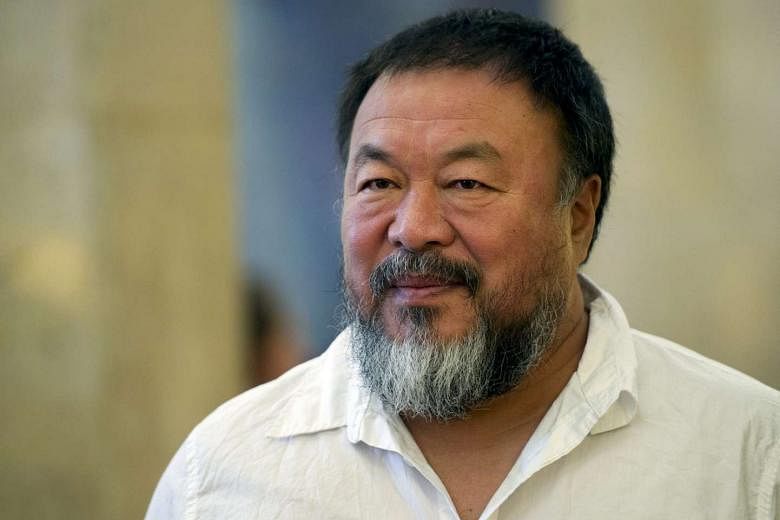BEIJING - At the height of Ai Weiwei's fame in 2011, I asked the staff working at a youth hostel in Guangxi what they thought about the controversial artist.
I was travelling in China at the time and a lot of international attention was on Ai. He had been detained for 81 days and charged with tax evasion by authorities, although critics claimed that this was done in retaliation for his criticism of the government.
"Who's Ai Weiwei?" was the blank-faced response the three hostel staff gave me.
The portly, bearded man who helped design Beijing's Olympic Stadium and filled the Tate Modern's Turbine Hall with millions of "sunflower seeds" - porcelain sculptures individually handcrafted by Chinese artisans - is renowned worldwide as a dissident and human rights activist.
But his name did not register even with a group of young people who had regular contact with international guests.
It came as a surprise to me, though not to my other Chinese friends when I related this incident to them. The son of revolutionary poet Ai Qing is not unknown, they said, but he is less famous and influential in China than he is made out to be abroad. It does not help that the 57-year-old gets minimal coverage in Chinese media.
But even among those who know him, there are divided opinions. Some of my local friends think he is overrated and uses politics to propagate his art. Others don't like the fact that he seems to play almost exclusively to a Western crowd.
So for better or worse, Ai's reputation precedes him, and these issues played on the mind when I recently visited his exhibition at Beijing's 798 art district, which was thronged by about 2,000 people when it opened.
Titled "Ai Weiwei", the exhibition made news simply because it was held. Local authorities had approved the show at Galleria Continua and Tang Contemporary Art, where he reconstructed a 400-year-old Ming dynasty-era wooden ancestral hall.
Originally built by a wealthy family in Jiangxi province, Ai had purchased, disassembled and rebuilt the Wang family's ancestral hall across the two exhibition spaces.
Reportedly given the go-ahead by authorities because there was no political agenda, the exhibition has returned him to some prominence, but has also cast him in a different light.
Local media gave some rare coverage to his return, with a Global Times editorial saying that it "may herald a new start" for the mainland's "most controversial" artist.
The editorial suggested that there are doubts about whether Ai's art is as valuable as the West claims, but it also said he should produce more work targeted at the Chinese public to help them understand modern art, given that "few in China are familiar with his work".
"Perhaps it's time to turn over the page on Ai's political controversy," it concluded.
Following the opening of his exhibition, Ai got back his passport which was revoked in 2011. He then travelled to Germany and the United Kingdom, where he came under some fire for apparently softening his views on the Chinese government.
In an interview with Reuters in August, he still directed criticism at China's politics and state control, but tempered it by adding: "You cannot just (dismiss) the other side as evil, which is too simple and it will not solve any problems."
In the same interview, he rejected the labels of activist and dissident, saying they are "put on" him.
But all the political news, thankfully, does not detract from his art.
His reconstruction of the ancestral hall, built by the Wang family to venerate their ancestor and 6th century prince Wang Hua, is an interesting examination of Chinese history, culture and function.
Ai said it was meant to create a new "social context" and identity for the hall, which had fallen into disuse after land and property were seized from the wealthy when the Communist Party came to power.
The size of the ancestral hall is imposing, but more importantly, it reflected history not just for the Wangs, but for China.
Chinese ancestral halls were, after all, once the centre of all important activities for families. It was considered a sacred place that held offerings and ceremonies for ancestors, as well as important social activities and meetings.
In the years after the Communist Party came to power, however, the hall was abandoned and used for storage by villagers. It fell into disrepair and its history was forgotten. Even the descendants of the Wang family became uninterested in reclaiming it when they were given a chance to.
The reconstruction itself is a nod to an age-old Chinese tradition of building, where columns and beams were independent and could be detached from walls.
Through this exercise, Ai could be said to have returned the ancestral hall to its former glory, but it also looks a pale shadow of its former self.
With only its wooden structure standing, the hall is hollowed out - as is its life. In the cavernous art galleries, the silence contrasts with the noise and human activity that once filled the interiors.
Old lanterns are lined neatly in a corner, like archeologists might do with excavation items. The viewer is left to contemplate whether the new Wang ancestral hall is a worthy recreation - and if there is any value in its reproduced form.
In that hour I spent at the galleries at 798, Ai the dissident certainly mattered less than Ai the artist.
As for whether it truly heralds a new start for him in China, we can only wait and see.





